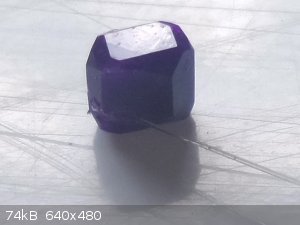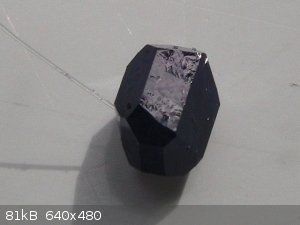| Pages:
1
2
3
4 |
Bezaleel
Hazard to Others
  
Posts: 444
Registered: 28-2-2009
Member Is Offline
Mood: transitional
|
|
From this thread (I think this is a more logical thread to post it):
Quote: Originally posted by MidLifeChemist  | Got it - ok I'm assuming the idea is that the iodide ions from the KI will replace the chloride ions. So why do you need to do this second step - to
get the Ni(en)3I2 the first time, did you simply boil away or evaporate the solution, is that why you need to recrystallize? And how do you know this
is the iodide and not the chloride? I couldn't find any references to Tris(ethylenediamine) nickel (II) iodide or to its solubility. It looks like an
interesting compound that I may want to try to make one day. Thanks in advance for the info!
|
The synthesis was from nickel sulphate which contained a few % nickelchloride as impurity. Ni(en)3SO4 and chloride hava a much higher solubility at
low temperatures. Hence adding KI solution will make the Ni(en)3I2 crystallise out on cooling. This is both concentration and pH critical (do add the
full 3 moles of (en)).
I used 7.38 g of NiSO4/NiCl2 (assumed to be NiSO4) in 50ml water. Then added 5.7ml (en) to 50ml water, and mixed both solutions. Let stand for a while
and filter off Ni(en)3(OH)2. Add at least 9.3g of KI and let crystallise in the cold (I used 5 C). I obtained a second batch by evaporating about half
the solution and cooling again.
As said, recrystallisation was an assumed purification step. The iodide is able to form beautiful multi-faceted crystals, see pictures.
[Modified from Gmelins Handbuch, 58 C pp 152-158]
 
|
|
|
woelen
Super Administrator
        
Posts: 7977
Registered: 20-8-2005
Location: Netherlands
Member Is Offline
Mood: interested
|
|
Very nice crystals! How large are they?
|
|
|
Bezaleel
Hazard to Others
  
Posts: 444
Registered: 28-2-2009
Member Is Offline
Mood: transitional
|
|
These are close-ups. The long side is 4 mm. I'm making more of this compound to continue growing.
|
|
|
woelen
Super Administrator
        
Posts: 7977
Registered: 20-8-2005
Location: Netherlands
Member Is Offline
Mood: interested
|
|
That's quite big already. My crystals of nickel complexes are at most 1 mm, but most of them are smaller, like table salt.
I really like the deep blue with a hint of purple of your crystals.
I also should try other anions than perchlorate. Perchlorate is nice and convenient, because it crystallizes so easily and for nearly all complex and
bigger cations, it is not hygroscopic, but the disadvantage is that with this you cannot make large crystals. Due to its lower solubility, it tends to
form many small crystals of sub-mm size.
I replenished my stock of perchloric acid two weeks ago (a new bottle of 500 ml of 60% acid), so that I can do more experiments with metal complexes,
but I'll also try with HBr (I also have 300 ml of 48% HBr). With chloride I never had really success. With many metal complexes I had issues of
concurrent coordination. Besides the ammine or (en) ligands, I also had chloride ligands, attached to the metal ions (especially with copper this is
easily the case) and strong hygroscopic properties, making crystallizations very difficult. Perchlorate itself is nearly inactive as a ligand, and
combined with its ease of crystallization, it almost is the perfect anion for this purpose. Apparently this also can be done very well with BF4(-),
but this ion is prone to hydrolysis to some extent (formation of HF and borate)., which is highly undesirable.
|
|
|
Bedlasky
International Hazard
    
Posts: 1219
Registered: 15-4-2019
Location: Period 5, group 6
Member Is Offline
Mood: Volatile
|
|
Woelen: Bromides are also strongly coordinating. Try sulfate or nitrate, they are weakly coordinating. Nitrate salt is energetic, so sulfate is better
option.
|
|
|
Bezaleel
Hazard to Others
  
Posts: 444
Registered: 28-2-2009
Member Is Offline
Mood: transitional
|
|
Quote: Originally posted by woelen  | That's quite big already. My crystals of nickel complexes are at most 1 mm, but most of them are smaller, like table salt.
I really like the deep blue with a hint of purple of your crystals.
I also should try other anions than perchlorate. Perchlorate is nice and convenient, because it crystallizes so easily and for nearly all complex and
bigger cations, it is not hygroscopic, but the disadvantage is that with this you cannot make large crystals. Due to its lower solubility, it tends to
form many small crystals of sub-mm size.
I replenished my stock of perchloric acid two weeks ago (a new bottle of 500 ml of 60% acid), so that I can do more experiments with metal complexes,
but I'll also try with HBr (I also have 300 ml of 48% HBr). With chloride I never had really success. With many metal complexes I had issues of
concurrent coordination. Besides the ammine or (en) ligands, I also had chloride ligands, attached to the metal ions (especially with copper this is
easily the case) and strong hygroscopic properties, making crystallizations very difficult. Perchlorate itself is nearly inactive as a ligand, and
combined with its ease of crystallization, it almost is the perfect anion for this purpose. Apparently this also can be done very well with BF4(-),
but this ion is prone to hydrolysis to some extent (formation of HF and borate)., which is highly undesirable. |
Perchloric acid would be a really nice to have. Have you bought it or made it? Since it's practically non-coordinating, it would be a very good
starter for making complexes. My guess is that Ni(en)3(ClO4)2 will have a high solubility, so addition of KI or KBr should provide the iodide or
bromide variety on cooling. I' m guessing here, though, since Gmelin has some complicated entries on the Ni(en)x perchlorates.
You mention other ligands, like BF4-. I guess that's a small ligand? Maybe IO4- could also work? It's larger than the perchlorate, bond lengths are
144 and 178pm respectively.
|
|
|
Bedlasky
International Hazard
    
Posts: 1219
Registered: 15-4-2019
Location: Period 5, group 6
Member Is Offline
Mood: Volatile
|
|
Periodate is strongly oxidizing. Ammonium periodate is shock sensitive, very unstable and explosive. [Ni(en)3](IO4)2 would be even worse - more
reducing agent and Ni as a metal catalyst.
|
|
|
DraconicAcid
International Hazard
    
Posts: 4278
Registered: 1-2-2013
Location: The tiniest college campus ever....
Member Is Offline
Mood: Semi-victorious.
|
|
Tetrafluoborateis not a ligand- it is very non-coordinating. Unlike perchlorates, it's also non-oxidizing.
Please remember: "Filtrate" is not a verb.
Write up your lab reports the way your instructor wants them, not the way your ex-instructor wants them.
|
|
|
Bezaleel
Hazard to Others
  
Posts: 444
Registered: 28-2-2009
Member Is Offline
Mood: transitional
|
|
Quote: Originally posted by Bedlasky  | | Periodate is strongly oxidizing. Ammonium periodate is shock sensitive, very unstable and explosive. [Ni(en)3](IO4)2 would be even worse - more
reducing agent and Ni as a metal catalyst. |
Thanks, I never worked with it, so I wasn't aware.
Correct, sorry about the wrong wording. It's just an ion, non-coordinating indeed.
(I must have been more tired than I thought wen posting my previous message...)
[Edited on 19-11-2020 by Bezaleel]
|
|
|
woelen
Super Administrator
        
Posts: 7977
Registered: 20-8-2005
Location: Netherlands
Member Is Offline
Mood: interested
|
|
I bought my perchloric acid, together with another member I bought one liter and we shared the cost, so that we both have 500 ml.
BF4(-) indeed can be used as a non-coordinating anion. I have NaBF4, but I noticed, that in the long run, hot near boiling solutions of this attack
glass (very slowly, but noticeably). The BF4(-) ion does hydrolyse a little, especially when heated. This is not fun at all, I value my glassware.
Maybe even some HF escapes from the solutions, but I doubt whether these quantities are significant.
Ni(en)3(ClO4)2 is not very soluble in cold water, while being more soluble in hot water (not exceptionally, but clearly more than in cold water). This
allows me to recrystallize this complex and get very pure and nice dry crystalline samples. This actually is the case for many perchlorates with
bigger anions. I already made numerous perchlorates from different metal complexes, but also from protonated amines (e.g. NH2CH3, NH(CH3)2, (en),
N(CH3)4(+)), and also from Cs(+) and Rb(+). The starting material is HClO4, or in some limited cases, NH4ClO4. Easiest and cheapest would be the
freely soluble NaClO4, but in the EU you cannot buy that anymore legally, so for me no NaClO4  . I noticed that in the cold, the perchlorates are remarkably stable. When heated in a flame, however, they burn quickly or even
deflagrate, if the cationic species contains organic parts. So, perchlorate is a nice alley in the quest for easily separated and purified complexes,
but its use requires some care. . I noticed that in the cold, the perchlorates are remarkably stable. When heated in a flame, however, they burn quickly or even
deflagrate, if the cationic species contains organic parts. So, perchlorate is a nice alley in the quest for easily separated and purified complexes,
but its use requires some care.
[Edited on 19-11-20 by woelen]
|
|
|
| Pages:
1
2
3
4 |